My 2AA battery sensor
-
I updated the first post regarding sleep mode power consumption. Current draw <0.1mA was too optimistic. My Fluke 87 detected mostly AC current. Beginners mistake and really embarrassing. I excuse me with that I do this hobby between 1 an 2 am.
Edit: This post should have been more elaborate. Please read further below for more info. To sum up - it's pretty good after all.
-
Hi @m26872
The radio is powered straight from the batteries because it's high qauality demand on its supply and that it's good with a voltage all the way down to 1.9V. I still use the 4,7uF capacitor on radio as precaution.
So straigh the setup look like this ? battery > stablize regulator > radio ?
Since its battery and low power is wanted, I always remove the voltage regulator and power led from the Arduino pro mini and the power led from the step-up regulator (or the series resistor).
Do you mind to share the how to?
I set my power monitoring to report linear with 1.9V as 0% (Vmin_radio) and 3.3V as 100% (instead of 3.44 just to increase resolution). Power consumption looks good.
Which method do you use? voltage divider or the using internal vRef ?
Thanks
-
Hi @m26872
The radio is powered straight from the batteries because it's high qauality demand on its supply and that it's good with a voltage all the way down to 1.9V. I still use the 4,7uF capacitor on radio as precaution.
So straigh the setup look like this ? battery > stablize regulator > radio ?
Since its battery and low power is wanted, I always remove the voltage regulator and power led from the Arduino pro mini and the power led from the step-up regulator (or the series resistor).
Do you mind to share the how to?
I set my power monitoring to report linear with 1.9V as 0% (Vmin_radio) and 3.3V as 100% (instead of 3.44 just to increase resolution). Power consumption looks good.
Which method do you use? voltage divider or the using internal vRef ?
Thanks
@funky81 said:
Hi @m26872
The radio is powered straight from the batteries because it's high qauality demand on its supply and that it's good with a voltage all the way down to 1.9V. I still use the 4,7uF capacitor on radio as precaution.
So straigh the setup look like this ? battery > stablize regulator > radio ?
No. There are two parallell supplies from the same battery. One is simple battery->radio and the other one battery->step-up-regulator->arduino (and sensors).
Since its battery and low power is wanted, I always remove the voltage regulator and power led from the Arduino pro mini and the power led from the step-up regulator (or the series resistor).
Do you mind to share the how to?
There are descriptions on the build site. Instead of cutting the traces I just unsolder the regulator (the black piece with 5 legs) and the red power led (usually right next to it). If you're planning to reuse any, it's probably better to cut traces or unsolder series resistors. For the step-up in particular it's easy to see which resistor the led connects to.
I set my power monitoring to report linear with 1.9V as 0% (Vmin_radio) and 3.3V as 100% (instead of 3.44 just to increase resolution). Power consumption looks good.
Which method do you use? voltage divider or the using internal vRef ?
Because of the step-up regulator the internal vRef-method isn't possible. I use voltage divider from build site and the code I posted earlier here. But for 2AAs use VMIN=1.9, VMAX= 3.3V and Volts-per-bit = 0.003363075; Vmin and Vmax you can adjust if you want.
Thanks
You're welcome.
Edit: Logical level difference between radio and arduino is outside specification when radion operates at 1.9V and arduino at 3.3V, but from my own tests and experiemce 1.9 is working ok as a very low limit. A battery alarm should of course be set above 0% anyhow.
-
As a general comment I'd like to complete the cross reference to this thread. It says why you should avoid the china step-up converter due to its high quiescent power draw (~ 1mA). If space is available e.g. a 4AA-supply via APM inbuilt regulator can give <25% sleep mode power consumption.
Edit: After a few months testing, I'm reassessing the efficiency of the China step-up. See below in this thread.
-
@m26872 said:
runtime 1-4 weeks
So this gives a runtime of 1-4 weeks? I am just starting out and wanted to confirm this. There are other posts claiming 6 months but I suspect that is in theory and the reality is 1-4 as you have experienced. Also, are any of your sensors interrupt driven that only wake up on outside feedback such as door switch? - I wonder if that will have more battery life.
-
@m26872 said:
runtime 1-4 weeks
So this gives a runtime of 1-4 weeks? I am just starting out and wanted to confirm this. There are other posts claiming 6 months but I suspect that is in theory and the reality is 1-4 as you have experienced. Also, are any of your sensors interrupt driven that only wake up on outside feedback such as door switch? - I wonder if that will have more battery life.
@MatrixIII No no, that was for how long I have had my system running when I wrote the first post in this thread. The battery time in practice highly depends on how much the node sleeps. Always on and always asleep will give you the extreme. I'd say 6 months is very reasonable. I'll see if I can show some examples....
-
Ok here are some of my logged battery levels. Note that some nodes had been running before logging was turned on and that I also like to drain already used batteries. I'll leave to the reader to extrapolate the trends and estimate life time, but I suspect that the last 20% shouldn't be taken into account. First exampel shows briefly why;
First one odd but illustrating example where I used two rechargeable 700mAh AAAs with one DS18B20, varying (very) temp and only 30s sleep. Any nodes transmission activity will temporary produce a lower voltage reading and make the curve look noisy. This band grows thick near the end of life and these low spikes are the ones to keep an eye on. Apart from that we see the typical "tilted S"-shaped battery discharge curve.
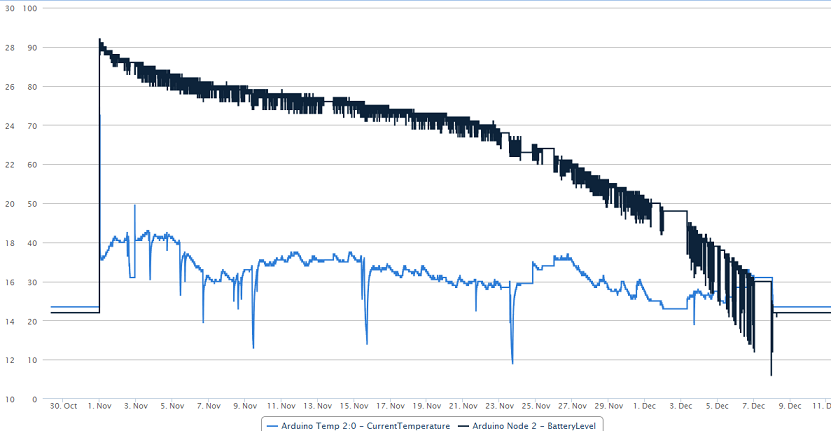
-
Next one is a rather nervous DHT22 with 30s sleep and supplied by two (initially fresh) normal alkaline AAs.
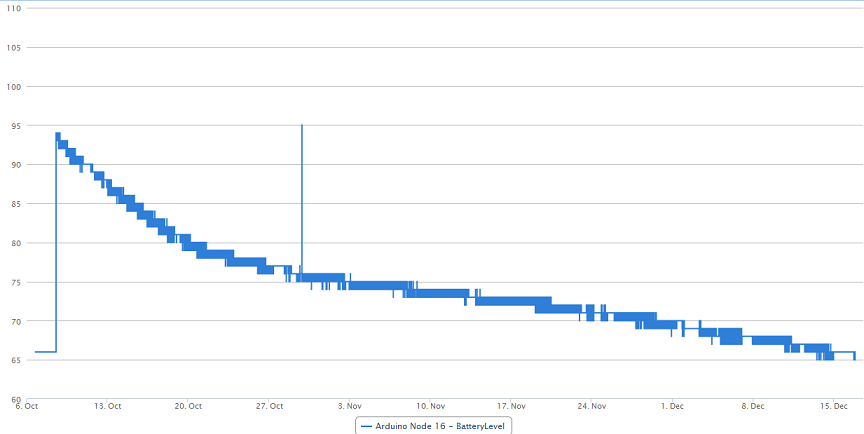
-
This one has two DS18B20s, 30s sleep. The sensors are attached to a central heating pipe. The heating system was turned on 1 Nov which is visible as new more battery consuming trend.
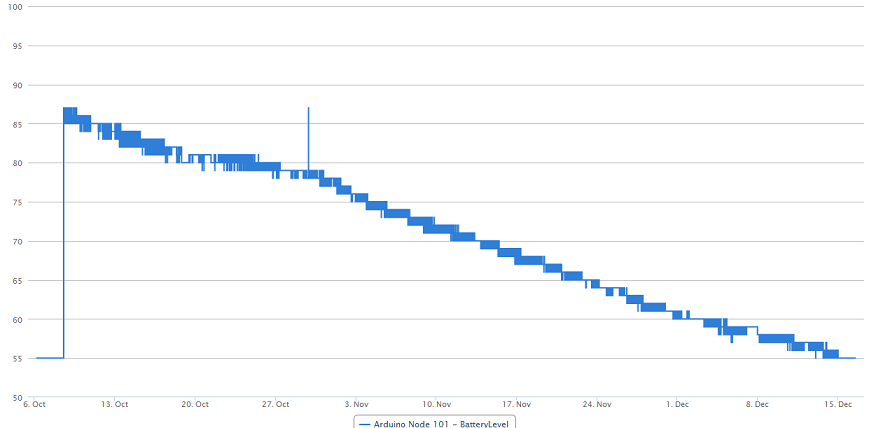
-
Here is the interrupt-driven (front) door switch sensor as requested. Unfortunately not with fresh AAs. Since it's almost always sleeping I think the power draw is surprisingly high. Explanation is of course the 1mA to the china step-up.
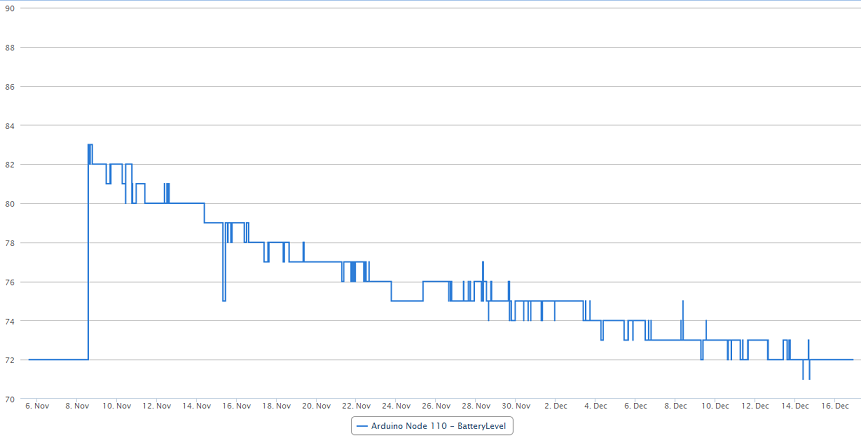
-
Finally are there two nodes started up at the same time, equally equipped with one BMP180 and one DHT22 each. Sleep time are more normal 15+5min. (15+5 because I now have learned to filter the DHT-readings and I do this here by measure a value 5 min before the real processing for avaraging purpose and to reduce risk of invalid readings.)
I'm confident this will survive 6 months since the decrease rate is 5% per month and it's still in the beginning of the "tilted S". The upper curve is with fresh batteries, the lower with used.

-
Very good analysis. I have just bought two lipo cells and a charger and a bunch of 9V battery cables. Sometime next year I hope to get the time to evaluate their use for power source to the sensors. Then I will also test my slightly more conservative battery level circuit described here.
-
Thanks.
I thought someone would ask why I expect a 3000mAh battery to supply 1mA for 6 months ?
-
Thanks.
I thought someone would ask why I expect a 3000mAh battery to supply 1mA for 6 months ?
@m26872 said:
Thanks.
I thought someone would ask why I expect a 3000mAh battery to supply 1mA for 6 months ?
Nice Work!! Oh and with the mods you have in place, I don't think you should have much problem getting to 6 months.. :-)
-
Thanks.
I thought someone would ask why I expect a 3000mAh battery to supply 1mA for 6 months ?
-
@m26872 said:
I thought someone would ask why I expect a 3000mAh battery to supply 1mA for 6 months ?
Ok, I'll be the straight man here: why do you expect a 3000mAh battery to supply 1mA for around 4400 hours?
@Zeph Thank you.
Because it's 90% mAac (from dc source) and I think the china step-up isn't really that crappy after all. Energizing-deenergizing a a coil with no load will look like this without any real power produced. Of course there are loss power and wear on battery etc, but not compareable to 1mAdc. Deeper investigation to this should be the subject of a new thread. -
I'm getting about 3-4 months from my less active sensors, and the only hardware mod I'm using is the Arduino LED removal. So I can image removing the regulator and step LED would save a fair amount of energy.
I really need to get around to removing those....
-
This are my results, with low power arduino powerd on 2 AA alkaline batteries.
Door/window sensor (front door - opens frequently). On ocrober 4 battery status 64%, december 18 62% (still at 62%). 100% spike is when I reprogram my sensor. In 75 days battery drops for 2 % -> 100% in more than 10 years.
Code is available on GitHub.EasyIoT server battery status
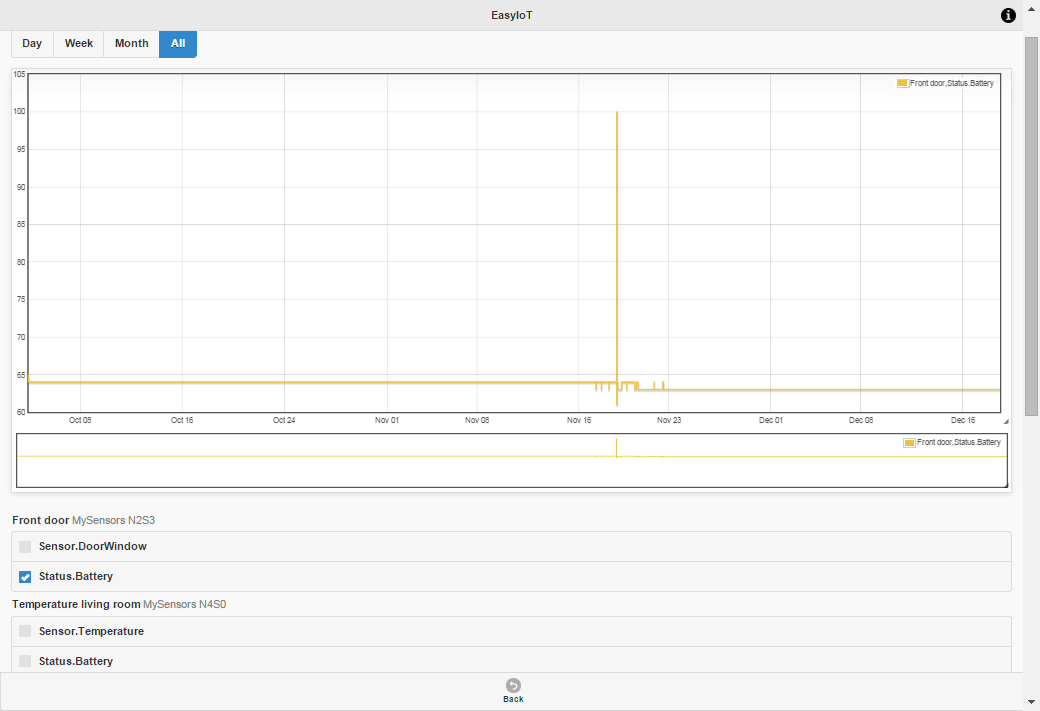
Temperature and humidity sensor with DHT22 and step up regulator. Arduino and NFR24L is powered directly on 2 AA batteries, DHT22 is powered on step up regulator but only when measure is taken. Battery drops for 14% in 75 days. Actually this design is not so good. I'm testing new design without step up regulator and better temperature/humidity sensor. 2AA alkaline batteries could last 10 years.

This is my water leak sensor. I'm using 2 wasted AA batteries for testing, and voltage actually rise. Current consumption is about 6uA (self discharge is about 10 times bigger) practically all the time.
-
This are my results, with low power arduino powerd on 2 AA alkaline batteries.
Door/window sensor (front door - opens frequently). On ocrober 4 battery status 64%, december 18 62% (still at 62%). 100% spike is when I reprogram my sensor. In 75 days battery drops for 2 % -> 100% in more than 10 years.
Code is available on GitHub.EasyIoT server battery status

Temperature and humidity sensor with DHT22 and step up regulator. Arduino and NFR24L is powered directly on 2 AA batteries, DHT22 is powered on step up regulator but only when measure is taken. Battery drops for 14% in 75 days. Actually this design is not so good. I'm testing new design without step up regulator and better temperature/humidity sensor. 2AA alkaline batteries could last 10 years.

This is my water leak sensor. I'm using 2 wasted AA batteries for testing, and voltage actually rise. Current consumption is about 6uA (self discharge is about 10 times bigger) practically all the time.
@dopustko Looks nice. Can you please share a more detailed description of your hardware?
Edit: I searched and saw that you're running at 1MHz and soon with HTU21T. Very elegant!
